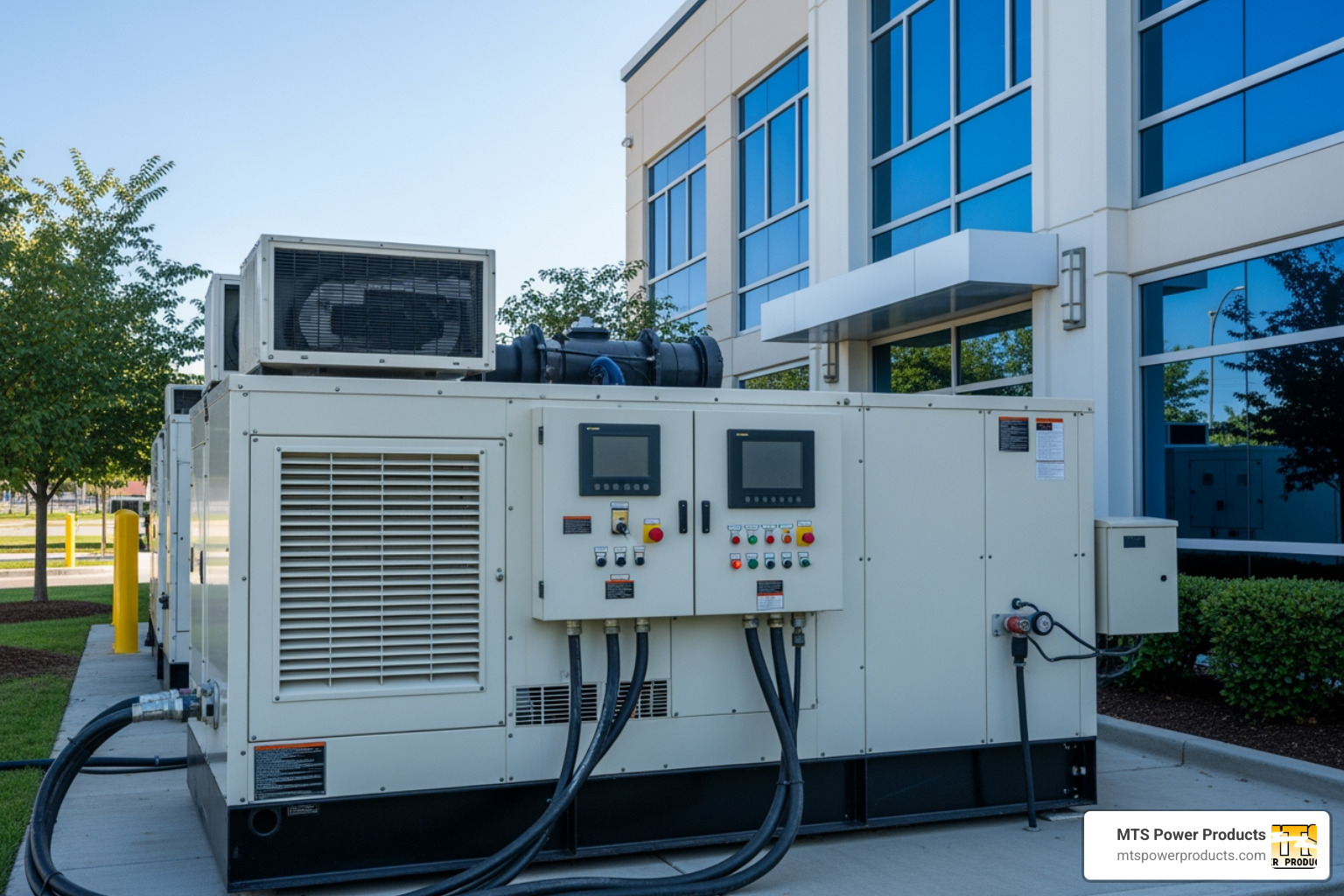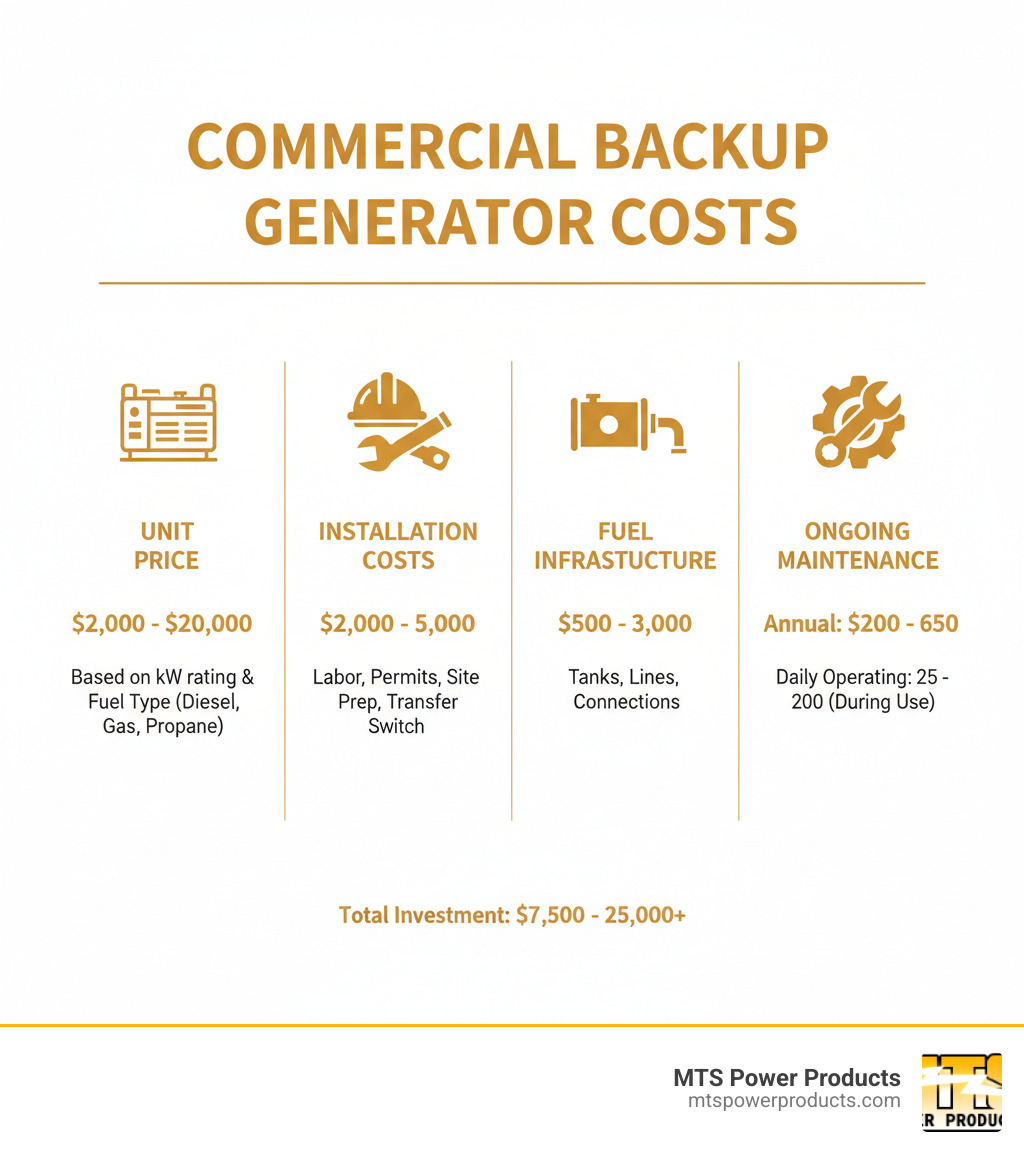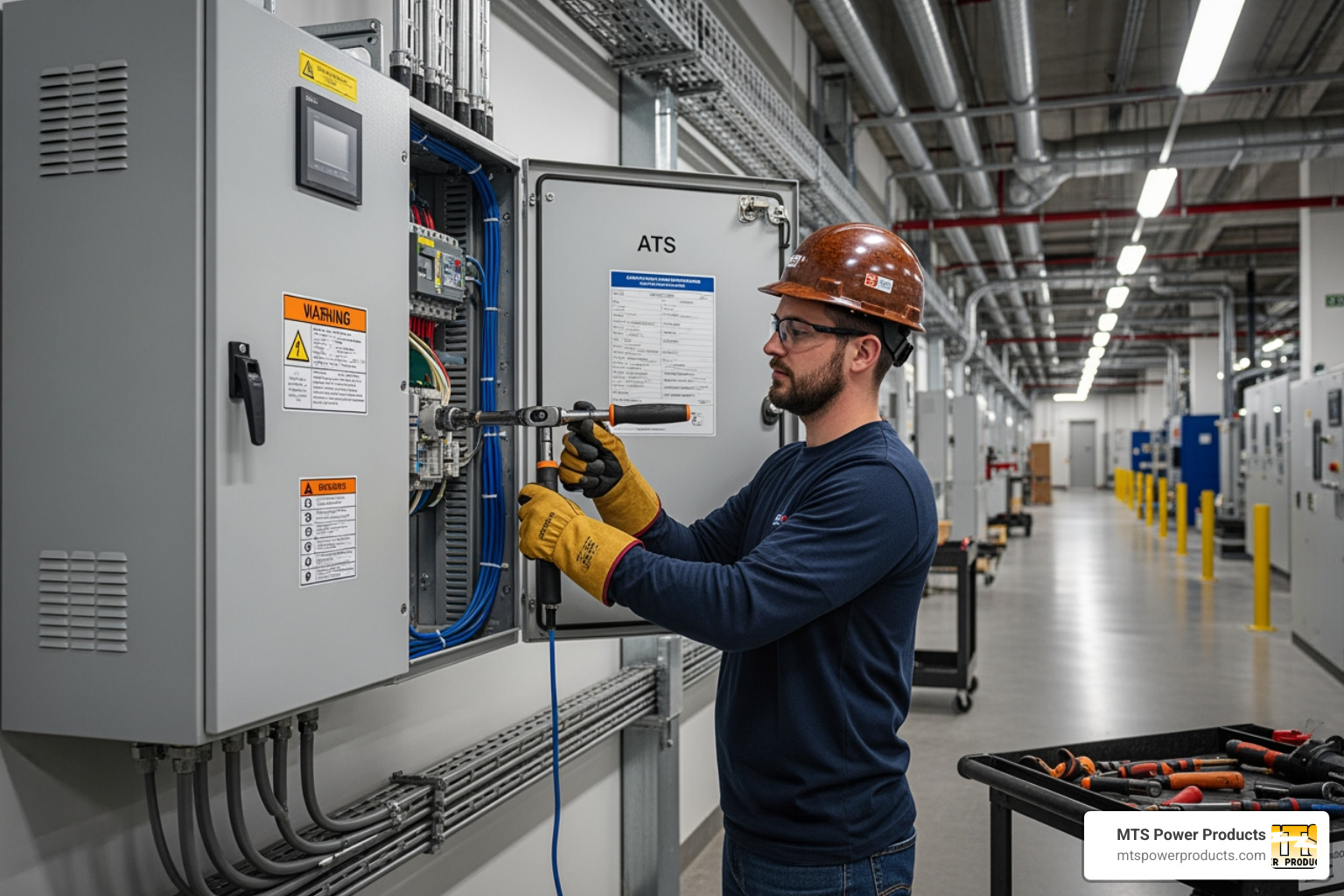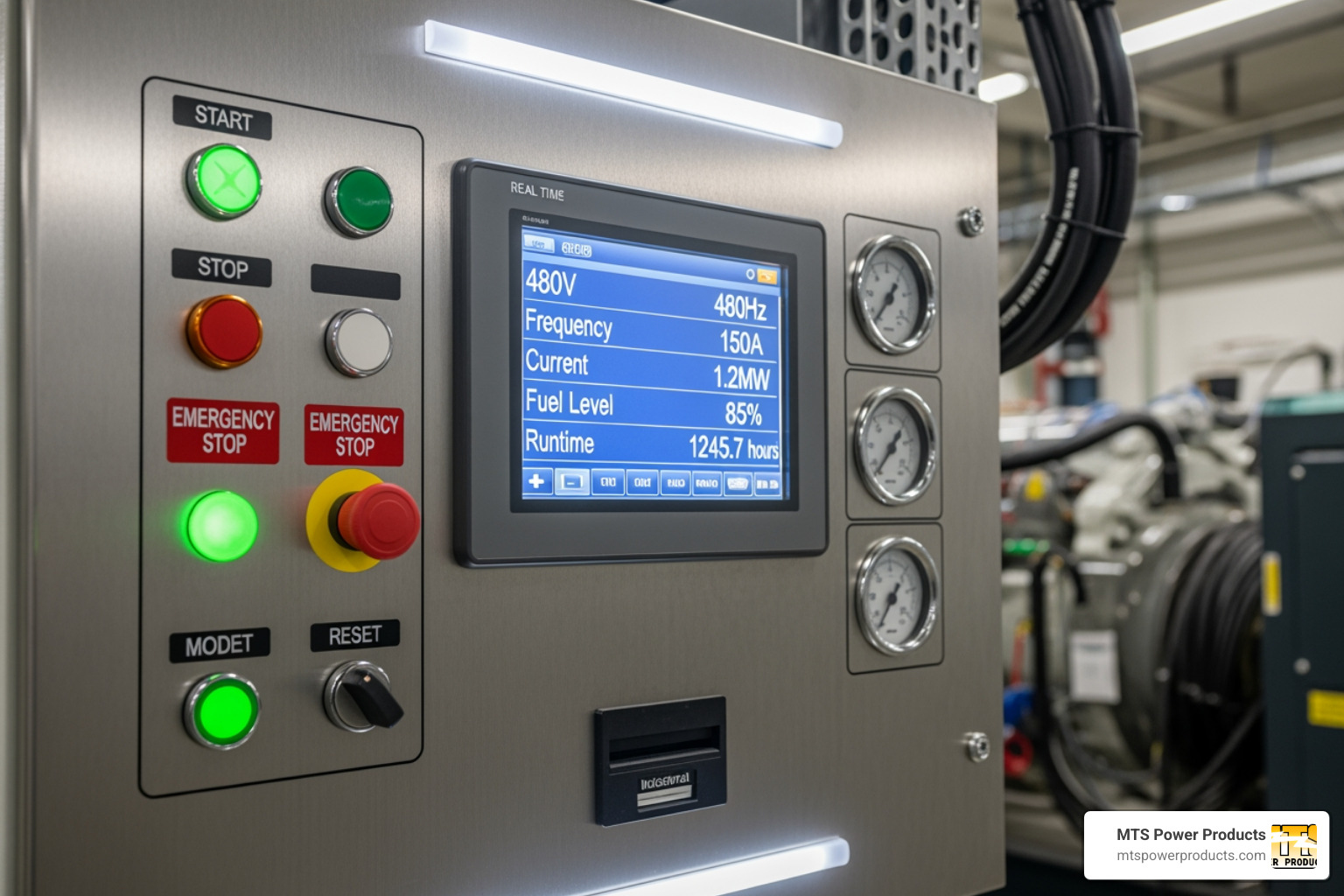
Buy Direct
from the Manufacturer
Sell our Products
Become a Distributor
Discounts
on volume purchases
Visit Us
at our Miami office
from the Manufacturer
Become a Distributor
on volume purchases
at our Miami office
Backup generator cost is a critical investment that ensures business continuity during power outages. When the power goes out, every minute translates to lost revenue, compromised data, and frustrated customers. Understanding the costs upfront helps you budget appropriately and protect your business from the devastating effects of power loss.
Total investment for a commercial installation typically ranges from $7,500 to $25,000+, broken down as follows:
Key cost drivers include:
For many businesses, the cost of a single extended outage far exceeds the investment in reliable backup power.

Quick look at backup generator cost:
When budgeting for a backup generator cost, you’re investing in a complete power solution. This includes the generator unit, professional installation, permits, site preparation, electrical work, and fuel connections. Skipping any step can compromise the system’s reliability.
The generator type significantly impacts your initial investment. For most businesses, permanently installed standby generators are the standard, but other types can serve specific needs.
| Generator Type | Average Price Range | Power Output (Commercial) | Typical Commercial Application |
|---|---|---|---|
| Standby | $2,000 – $20,000+ | 7kW – 150kW+ | Whole facility backup, critical systems, data centers, manufacturing |
| Portable | $500 – $3,000 | 1KW – 9.5KW | Temporary power for job sites, small events, remote operations |
| Inverter | $400 – $5,000 | 1KW – 7KW | Sensitive electronics, quiet operation for events, small office essentials |
Standby generators are the workhorses of commercial backup power, automatically activating within seconds of an outage. A 13 kW unit starts around $4,000, while a 20 kW unit might be $5,500. Large commercial units (150 kW+) can easily exceed $20,000.
Portable generators ($500 – $3,000) are budget-friendly options for construction sites, remote operations, or powering specific equipment. You can find options like a 7,500-watt generator from Home Depot in this category.
Inverter generators ($400 – $5,000) produce cleaner, quieter power, making them ideal for sensitive electronics like computers or for events where noise is a concern.
Professional installation is critical and often costs as much as the generator itself, typically ranging from $2,500 to $15,000 or more. The average is around $4,520 for smaller commercial jobs.

Key installation components include:
You can learn more about installation from Angi to understand typical costs. At MTS Power Products, we are experts in custom generator installations in Miami, Florida, handling everything from site assessment to final inspection to ensure your backup generator cost delivers maximum value.
Several factors influence your total backup generator cost, from the upfront investment to long-term operational expenses. Your total investment depends on the generator’s size, fuel source, brand, features, and even your location. Let’s break down each factor to help you make an informed decision.
One of the most significant cost drivers is the generator’s size, measured in kilowatts (kW). Choosing the right size is crucial: an undersized unit won’t power your essential equipment, while an oversized one costs more upfront and runs inefficiently.
Start with a load calculation by listing all critical equipment and their wattage. Remember to account for “surge wattage”—the extra power motors in HVAC systems or refrigeration units draw on startup. You must decide whether to power your entire facility or just essential systems like lighting, POS systems, security, and critical computers. Powering everything (full-facility power) requires a much larger and more expensive generator.
Common commercial power needs include:
Under-sizing leads to insufficient power, while over-sizing wastes money and can cause “wet-stacking,” which shortens the generator’s lifespan. Running a generator at 50-75% of its capacity is ideal. We recommend consulting with our experts at MTS Power Products for an accurate load calculation to right-size your system.
Your choice of fuel significantly impacts both initial backup generator cost and ongoing expenses.
Running costs per hour vary by fuel type, generator size, and load. A 15-20 kW generator can cost $90 to $200 per day to operate. While a smaller unit like a 7,500-watt generator from Home Depot may suit small needs, most commercial applications require more robust solutions.
Modern features add to the upfront backup generator cost but provide significant long-term value and peace of mind.

The Automatic Transfer Switch (ATS) is the most critical feature. It automatically detects an outage, starts the generator, and transfers the load in seconds. The ATS itself costs $600 to $1,200. Our McPherson Controls line offers professional-grade transfer switches with advanced safety features.
Other valuable features include:
At MTS Power Products, we specialize in providing professional quality generators and transfer switches from our Miami location, featuring advanced capabilities like programmable displays and remote monitoring.
The true backup generator cost includes long-term expenses, known as the Total Cost of Ownership (TCO). This covers fuel, regular maintenance, and potential repairs over the generator’s lifespan. Budgeting for these ongoing costs is just as important as planning for the initial purchase.
Ongoing expenses primarily consist of fuel costs during outages and routine maintenance.
Fuel consumption rates vary based on the generator’s load. A unit powering your entire facility will use fuel much faster than one running only essential systems. The cost per day of use for a mid-sized (15-20 kW) generator is typically between $90 and $200.
Proper maintenance is not optional; it’s essential for ensuring your generator works when you need it. A neglected generator is likely to fail during an emergency.
Annual maintenance contracts ($200 – $650 per year for smaller systems) are a smart investment. A professional will inspect your system, change fluids and filters, and test the battery, ensuring it’s ready for peak storm season.
Most generators perform automatic weekly self-tests, running for 10-20 minutes to stay in shape. This consumes minimal fuel (about $5-$10 per month) but is vital for readiness. Other routine checks include:
With proper care, a quality commercial standby generator has an impressive expected lifespan of 10,000 to 30,000 running hours. This can translate to 25 to 40 years of service. How maintenance affects longevity cannot be overstated; it is the single most important factor in maximizing your return on investment. Regular service prevents small issues from becoming expensive failures.
At MTS Power Products, we provide comprehensive maintenance services from our Miami location to protect your investment and ensure your backup power is always ready.
A generator isn’t just an expense—it’s a strategic investment that protects revenue, safeguards your reputation, and may offer tax benefits. When evaluating the backup generator cost, it’s crucial to consider its return on investment (ROI).

For businesses in Miami, where storms are a regular threat, the cost of downtime is a real and significant risk. A single extended outage can be financially devastating due to:
The cost of a single outage can easily exceed $14,000 for a typical business. Compared to this risk, a $7,500 to $25,000 generator system is a sound investment in business continuity.
Yes, commercial backup generators typically qualify for significant tax benefits, which can substantially reduce your net cost.
Your generator is considered capital equipment, allowing you to depreciate its cost over its useful life according to standard depreciation schedules. This provides an ongoing tax benefit.
Better yet, many businesses can use the Section 179 deduction to deduct the full purchase price of the generator in the year it’s placed into service. This provides a significant upfront tax saving rather than spreading it out over years. For a $15,000 installation, this could mean $3,000 to $5,000 in tax savings in the first year.
We always recommend consulting a tax professional to understand how these deductions apply to your specific situation. Also, investigate potential local incentives in Florida, as some municipalities or utilities offer programs for businesses that invest in emergency preparedness.
At MTS Power Products, we help South Florida businesses make smart power decisions. Factoring in tax benefits and the high cost of downtime makes the case for a quality backup generator clear.
The total installed backup generator cost varies based on your needs. Expect to invest:
Overall, most businesses should budget $7,500 to $25,000+ for a complete solution. The generator unit is a major part of the cost, but professional installation—including labor, permits, and the automatic transfer switch—can add 50-100% to the total.
Choosing the right size is critical to avoid wasting money or being left without power. The process involves:
While this gives you a ballpark figure, we strongly recommend consulting with a qualified electrician or generator specialist like our team at MTS Power Products. A professional load calculation ensures you get a generator that perfectly matches your needs without costly errors.
Yes, a permanently installed standby generator is a tangible asset that adds significant value to a commercial property, especially in South Florida.
For a potential buyer or tenant, a facility with pre-installed backup power offers immediate business continuity and operational resilience. It signals that the property is prepared for outages, protecting inventory, data, and revenue. This makes your property more attractive and competitive in the real estate market, whether you are selling or leasing.
Investing in a commercial generator is about protecting your business. We’ve covered every aspect of backup generator cost, from the initial purchase and installation to long-term maintenance. While the investment is real, it pales in comparison to the cost of a single extended power outage, with its lost revenue, compromised data, and damage to your reputation.
For businesses in Miami and South Florida, where hurricanes and grid failures are a reality, backup power is not a luxury—it’s a necessity for survival. Having a plan keeps you operational while competitors are dark.
At MTS Power Products, we are your partners in business continuity. Located in Miami, we understand the challenges local businesses face. Our McPherson Controls line offers professional-grade transfer switches and controls with advanced features like remote monitoring. As a direct manufacturer, we provide professional quality at fair prices, backed by expert technical support to ensure your system is sized, installed, and maintained correctly.
The peace of mind from knowing your business will keep running is priceless. Let us help you achieve it.
Ready to protect your business with confidence? Explore our range of commercial backup generators and contact us to discuss your specific needs.
